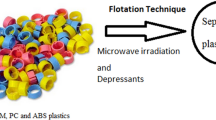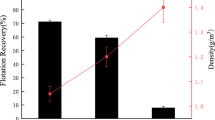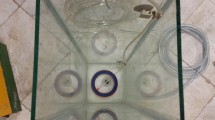Abstract
The influential separation of an individual plastic from a mixture of waste plastics is a crucial factor for the quality evaluation of the recycled product. The selected engineering plastics available in municipal and industrial wastes including, acrylonitrile butadiene styrene, polycarbonate, and poly oxy methylene microwave irradiated for different microwave powers. The irradiated plastics conditioned with the selected dual depressants with different concentrations and after that, they introduced into the flotation tank with tap water as liquid media. The effects of microwave power and depressant concentration on the hydrophilic-hydrophobic (sink-float) properties of the plastic surface evaluated. It revealed, the microwave irradiation changed the capacity (the adsorbed depressant mono or multilayer molecules), numbers, and concentration of the plastic surface active sites. It resulted in different sink-float properties of the studied plastics. It was beneficial for the flotation of some plastics and depressants. The results evidenced by different techniques including, contact angles (θ), ATR-FTIR spectra, and AFM and SEM images. The driven equations by a design of experiment software (Design-Expert \(\circledR\)) showed suitable conformity between the predicted and actual plastic flotation values.










Similar content being viewed by others
Data Availability
The datasets generated during and/or analysed during the current study are available from the corresponding author on reasonable request.
References
Wang CQ, Wang H, Fu JG, Liu YN (2015) Flotation separation of waste plastics for recycling: a review. Waste Manag 41:28–38
Al-Salem SM, Lettieri P, Baeyens J (2009) Recycling and recovery routes of plastic solid waste (PSW): a review. Waste Manag 29:2625–2643
Gu F, Guo J, Zhang W, Summers PA, Hall P (2017) From waste plastics to industrial raw materials: a life cycle assessment of mechanical plastic recycling practice based on a real-world case study. Sci Total Environ 601–602:1192–1207
Hopewell J, Dvorak R, Kosior E (2009) Plastics recycling: challenges and opportunities. Philos Trans R Soc B: Biolog Sci 364:2115–2126
Li J, Wu G, Xu Z (2015) Tribo-charging properties of waste plastic granules in process of tribo-electrostatic separation. Waste Manag 35:36–41
Wu G, Li J, Xu Z (2013) Triboelectrostatic separation for granular plastic waste recycling: a review. Waste Manag 33:585–597
Silveira AVM, Cella M, Tanabe EH, Bertuol DA (2018) Application of triboelectrostatic separation in the recycling of plastic wastes. Process Saf Environ 114:219–228
Pappa G, Boukouvalas C, Giannaris C, Ntaras N, Zografos V, Magoulas K, Tassios D (2001) The selective dissolution/precipitation technique for polymer recycling: a pilot unit application. Resour Conserv Recycl 34:33–44
Weeden GS, Soepriatna NH, Wang NL (2015) Method for efficient recovery of high-purity polycarbonates from electronic waste. Environ Sci Technol 49:2425–2433
Zhao Y, Lv X, Yang W, Ni H (2017) Laboratory simulations of the mixed solvent extraction recovery of dominate polymers in electronic waste. Waste Manag 69:393–399
Malcolm Richard G, Mario M, Javier T, Susana T (2011) Optimization of the recovery of plastics for recycling by density media separation cyclones. Resour Conserv Recycl 55:472–482
Lee JJS, Mo JPT, Wu DY (2012) Polymer recovery from auto shredder residue by projectile separation method. Sustain-Basel 4:643–655
Gent R, Menendez MM, Toraño J, Torno S (2011) Optimization of the recovery of plastics for recycling by density media separation cyclones. Resour Conserv Recycl 55:472–482
Gent M (2009) Recycling of plastic waste by density separation: prospects for optimization. Waste Manag Res 27:175–187
Fraunholcz N (2004) Separation of waste plastics by froth flotation-a review, part I. Miner Eng 17:261–268
Alter H (2005) The recovery of plastics from waste with reference to froth flotation. Resour Conserv Recycl 43:119–132
Shen H, Forssberg E, Pugh R (2001) Selective flotation separation of plastics by particle control. Resour Conserv Recycl 33:37–50
Negari MS, Movahed SO, Ahmadpour A (2018) Separation of polyvinylchloride (PVC), polystyrene (PS) and polyethylene terephthalate (PET) granules using various chemical agents by flotation technique. Sep Purif Technol 194:368–376
Davari MR, Movahed SO (2019) The flotation by selected depressants as an efficient technique for separation of a mixed acrylonitrile butadiene styrene, polycarbonate and polyoxymethyleneplastics in waste streams. J Polym Environ 27:1709–1720
Burat F, Güney A, Kangal MO (2009) Selective separation of virgin and postconsumer polymers (PET and PVC) by flotation method. Waste Manag 29:1807–1813
Takoungsakdakun T, Pongstabodee S (2007) Separation of mixed post-consumer PET–POM–PVC plastic waste using selective flotation. Sep Purif Technol 54:248–252
Kangal MO (2010) Selective flotation technique for separation of PET and HDPE used in drinking water bottles. Miner Process Extr Metall Rev 31:214–223
Basařová P, Bartovská L, Kořínek K, Horn D (2005) The influence of flotation agent concentration on the wettability and flotability of polystyrene. J Colloid Interface Sci 286:333–338
Yuce AE, Kilic M (2015) separation of PVC/PET mixture from plastic wastes using column flotation technique. J Environ Prot Ecol 16:705–715
Guo J, Li X, Guo Y, Ruan J, Qiao Q, Zhang J, Bi Y, Li F (2016) Research on flotation technique of separating pet from plastic packaging wastes. Procedia Environ Sci 31:178–184
Yenial U, Burat F (2013) Separation of PET and PVC by flotation technique without using alkaline treatment. Miner Process Extr Metall Rev 34:412–421
Pascoe RD (2005) The use of selective depressants for the separation of ABS and 65 HIPS by froth flotation. Miner Eng 18:233–237
Güney A, Özdilek C, Kangal MO, Burat F (2015) Flotation characterization of PET and PVC in the presence of different plasticizers. Sep Purif Technol 151:47–56
Motasemi F, Afzal MT (2013) A review on the microwave-assisted pyrolysis technique. Renew Sustain Energy Rev 28:317–330
Molanorouzi M, Mohaved SO (2016) Reclaiming waste tire rubber by an irradiation technique. Polym Degrad Stab 128:115–125
Khavarnia M, Movahed SO (2016) Butyl rubber reclamation by combined microwave radiation and chemical reagents. J Appl Polym Sci 133:43363–43373
Movahed SO, Ansarifar A, Zohuri G, Ghaneie N, Kermany Y (2016) Devulcanization of ethylene–propylene–diene waste rubber by microwaves and chemical agents. J Elastom Plast 48:122–144
Mallampati SR, Lee CH, Park MH, Lee BK (2018) Processinplastics from ASR/ESR waste: separation of poly vinyl chloride (PVC) by froth flotation aftemicrowave-assisted surface modification. J Mater Cycles Waste Manag 20:91–99
Huang L, Wang H, Wang C, Zhao J, Zhang B (2017) Microwave-assisted surface modification for the separation of polycarbonate from poly methyl methacrylate and polyvinyl chloride waste plastics by flotation. Waste Manag Res 35:294–300
Mallampati SR, Lee CH, Park MH, Lee BK (2018) Processing plastics from ASR/ESR waste: separation of poly vinyl chloride (PVC) by froth flotation after microwave-assisted surface modification. J Mater Cycles Waste Manag 20:91–99
Truc NT, Lee BK (2017) Combining ZnO/microwave treatment for changing wettability of WEEE styrene plastics (ABS and HIPS) and their selective separation by froth flotation. Appl Surf Sci 420:746–752
Irannajad M, Mehdilo A, Nuri OS (2014) Influence of microwave irradiation on ilmenite flotation behavior in the presence of different gangue minerals. Sep Purif Technol 132:401–412
Cheng G, Li Z, Cao Y, Jiang Z (2020) Research progress in lignite flotation intensification. Int J Coal Prep Util 40:59–76
Shen H, Forssberg E, Pugh RJ (2002) Selective flotation separation of plastics by chemical conditioning with methyl cellulose. Resour Conserv Recycl 35:229–241
Aumann T, Theirich D, Engemann J (2001) Rapid surface modification of polyethylene in microwave and r.f.-plasmas: comparative study. Surf Coat Technol 142–144:169
Zhao Q, Gu X, Zhang S, Dong M, Jiang P, Hu Z (2014) Surface modification of polyamide 66 fabric by microwave induced grafting with 2-hydroxyethyl methacrylate. Surf Coat Technol 240:197–203
Saleh NS, Movahed SO, Attarbashi F (2018) Study on the anti-biofouling effects of the grafted polyamide 6 fibers by several vinyl chemicals. J Appl Polym Sci 135:46760–46770
Ginn BT, Steinbock O (2003) Polymer surface modification using microwave-oven-generated plasma. Langmuir 19:8117–8118
Kirwan LJ, van Fawell PD, Bronswijk W (2003) In situ FTIR-ATR examination of poly (acrylic acid) adsorbed onto hematite at low pH. Langmuir 19(14):5802–5807
Masel IR (1996) Principles of adsorption and reaction on solid surfaces. Wiley, New York
Zhao Y, Yang S, Wen H, Shen Z, Han F (2019) Adsorption behavior and selectivity mechanism of flotation reagents applied in ternary plastic mixtures. Waste Manag 87:565–576
Gregg GC, Sing KSW (1982) Adsorption, surface area and porosity, 2nd edn. Academic, London
Jiang H, Zhang Y, Wang H (2020) Surface reactions in selective modification: the prerequisite for plastic flotation. Environ Sci Technol 54:9742–9756
Zhang Y, Jiang H, Wang H, Wang C (2020) Separation of hazardous polyvinyl chloride from waste plastics by flotation assisted with surface modification of ammonium per sulfate: process and mechanism. J Hazard Mater 389:121918
Stat-Ease Handbook for Experimenters, Copyright ©2018 Stat-Ease, Inc. 2021 East Hennepin Ave, Suite 480 Minneapolis, MN 55413
Acknowledgements
The authors sincerely thank the staffs of the polymer chemistry laboratory located at faculty of science, Ferdowsi University of Mashhad for their sincere cooperation. Approval no. 3/53616.
Funding
The authors have not disclosed any funding.
Author information
Authors and Affiliations
Contributions
HH, SOM, and SJ designed the experiments. Dr. SOM prepared the manuscript with contributions from all co-authors. The authors applied the SDC approach for the sequence of authors.
Corresponding author
Ethics declarations
Conflict of interest
The authors have not disclosed any competing interests.
Additional information
Publisher's Note
Springer Nature remains neutral with regard to jurisdictional claims in published maps and institutional affiliations.
Rights and permissions
About this article
Cite this article
Hoseini, H., Ostad Movahed, S. & Jourabchi, S. The Float-Sink Behavior of Selected Pre-microwave Irradiated Plastics by Surface Adsorption of Several Dual Depressants. J Polym Environ 30, 2824–2836 (2022). https://doi.org/10.1007/s10924-022-02394-5
Accepted:
Published:
Issue Date:
DOI: https://doi.org/10.1007/s10924-022-02394-5




